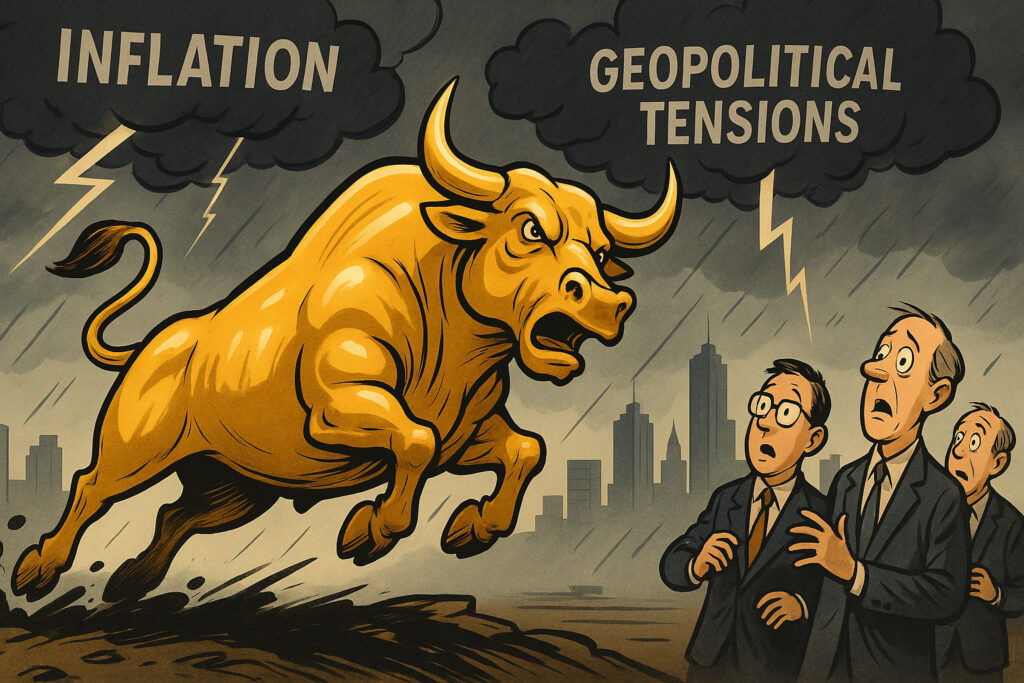Date: April 6, 2025
Gold prices soared past the $2,300 per ounce mark on April 6, 2025, reaching an all-time high and reinforcing its status as a safe-haven asset amid escalating global uncertainty. The precious metal’s rally comes as investors digest a confluence of inflationary pressures, renewed geopolitical conflicts, and market volatility, all contributing to heightened demand for protective assets.
Key Drivers Behind the Surge
1. Surging Inflation Expectations
U.S. and global inflation figures have continued to surprise to the upside in recent months. Core CPI data released earlier this week showed annualized inflation rising to 4.4%, well above central bank targets. Despite efforts by major central banks to maintain tighter policy stances, inflation remains sticky due to persistent wage growth and elevated commodity prices.
Gold, which is typically seen as a hedge against inflation, has benefited immensely from these conditions. Real yields, adjusted for inflation, have remained negative in several economies, further enhancing the appeal of non-yielding assets like gold.
2. Rising Geopolitical Risks
Markets have also been rattled by renewed geopolitical tensions in both Eastern Europe and the Middle East. The latest flare-up between Ukraine and Russia, along with fresh military activity in the Strait of Hormuz, has driven a spike in oil prices and raised concerns about global supply chains.
Investors seeking safety have turned to gold, reinforcing its role as a geopolitical hedge. Data from the World Gold Council shows significant inflows into gold ETFs in the last two weeks, reflecting a broader rotation into risk-averse assets.
3. Central Bank Buying Activity
In addition to retail and institutional demand, central banks have also been active buyers. According to newly released IMF figures, global central bank gold reserves grew by 35 tonnes in March, led by purchases from China, Turkey, and India. Central banks are diversifying away from the U.S. dollar amid concerns over fiscal policy sustainability and long-term debt dynamics.
This broad-based demand provides a strong structural foundation for gold prices, bolstering investor confidence.
4. Currency Market Volatility
The U.S. dollar index (DXY) fell 0.6% today, adding to recent declines as the Federal Reserve faces increased pressure to pause further rate hikes. A weakening dollar typically boosts gold by making it cheaper for holders of other currencies.
Simultaneously, emerging market currencies are under strain due to tightening financial conditions, prompting domestic investors in those countries to seek refuge in gold.
Market Reaction and Technical Levels
Spot gold surged as high as $2,312 per ounce during U.S. trading hours before settling slightly lower at $2,305, still up 2.1% for the day. Gold futures for June delivery also gained 2.3% to trade at $2,308.
Technical analysts point to $2,320 as the next major resistance level, with support seen around the $2,270 level. Momentum indicators, including the Relative Strength Index (RSI), have entered overbought territory, suggesting potential short-term consolidation but strong medium-term support.
Implications for Investors
Portfolio Diversification
Investors looking to hedge portfolios should consider allocating a portion to gold or gold-related assets such as mining stocks or ETFs. In periods of elevated inflation and geopolitical uncertainty, gold historically outperforms other major asset classes.
Inflation Hedge
With central banks struggling to control inflation without derailing growth, the case for gold as an inflation hedge remains robust. Investors may seek to increase their exposure to commodities more broadly, including precious metals and energy.
Tactical Trading Opportunities
For active traders, the recent breakout offers both momentum plays and options strategies. Gold call options have seen a spike in open interest, and volatility-based strategies could benefit from current market dynamics.
Expert Commentary
Market strategist Julia Reinhardt at Zurich Commodities said, “We’re witnessing a perfect storm for gold: inflation fears, geopolitical turmoil, and a weakening dollar. Until we see clear evidence that inflation is retreating and geopolitical tensions are easing, gold will likely remain in high demand.”
What Comes Next?
Looking forward, market participants will keep a close eye on upcoming U.S. CPI data due next Wednesday and any signals from the Federal Reserve’s next policy meeting. A continued rise in inflation or further escalation in international conflict could easily propel gold beyond $2,350.
Conversely, a surprise drop in inflation data or a Fed pivot could trigger profit-taking. However, the longer-term trend remains positive as global macroeconomic uncertainty persists.
Summary
April 6, 2025, will be remembered as the day gold crossed $2,300, marking a pivotal moment in the ongoing shift toward safe-haven assets. In an environment fraught with uncertainty—from inflation woes to geopolitical flare-ups—gold has once again proven its enduring value.
